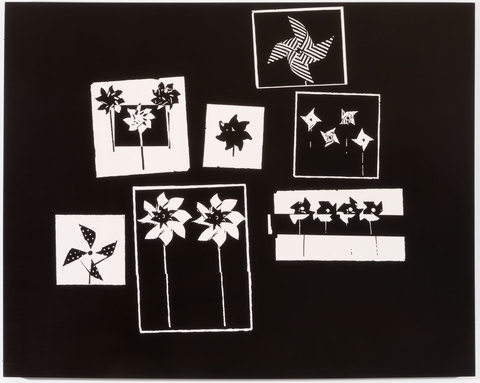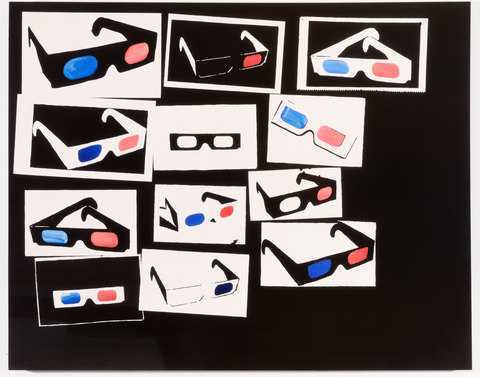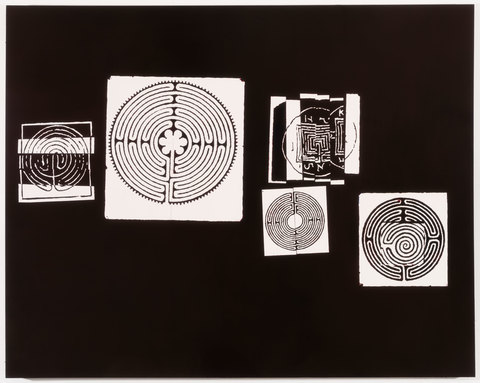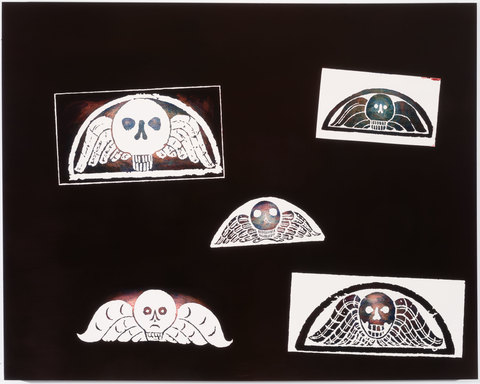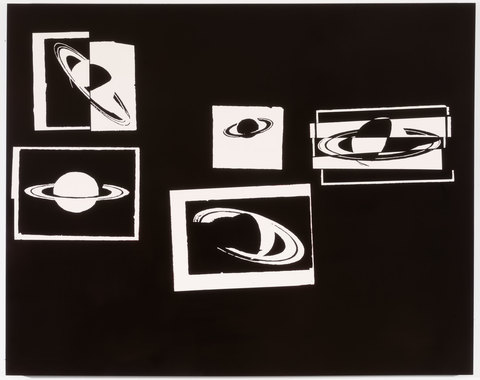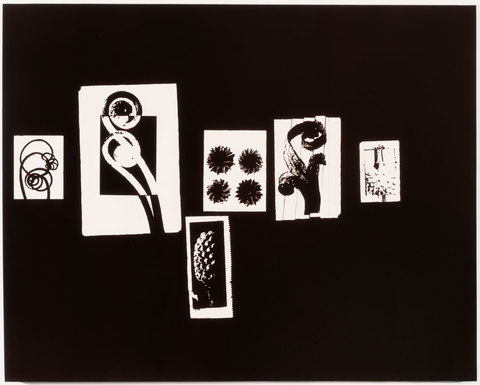Dissemblage is a neologism: a new, made-up word that describes an artistic technique. In keeping with surrealist neologisms such as Assemblage, Frottage, Decoupage, and Collage, Dissemblage takes the word "dissemble" as a root, and describes using stencils to create imagery. In this way, it proposes the surface of painting as a stage. To dissemble is to deceive, to mislead. These paintings dissemble: they present illusionistic space via its opposite, literal material. Stencils create a tension between the gestalt induced by the relationship between figure and ground in a painting. With Dissemblage, the white gesso ground of the painting functions also to create the figure; stencils mark a rupture of the surface and produce images. These images are indexical, inviting a reading of the photographic in passages of oil paint.
Each of these paintings is organized around a theme or motif: labyrinths, 3-D glasses, pinwheels and Saturn, for example. They are a kind of catalog. But the deeper theme is imagery and photography: not labyrinths, but images of labyrinths; not Saturn, but photos of Saturn. So the surfaces of the paintings fluctuate between the literal and the illusionistic. They are bulletin boards, with pictures pinned to them that themselves describe an illusionistic space that is not shared by the other images pinned to the board, or by the painting as a whole. The surfaces dissemble, suggesting illusion and denying it as well, or at least inviting an acknowledgement of illusion as a tool of art, and not as a natural given.
The founding Dissemblage painting is "After KB", which presents a selection of appropriated Karl Blossfeldt photographs, the celebrated photographer who compelled the surrealists to find the uncanny in his images of plants. Blossfeldt's contact sheets organize photographic images of plant forms in a straightforward, documentary format. This practice abstracted the subjects of his images, separating them from the environment in which they exist and inviting an understanding of image-making that demonstrates a pictorial but non-illusionistic value. With these Dissemblage paintings, I apply this approach to both painting, and to images of other "natural" forms than plants. With Dissemblage, the viewer is aware that they are looking both at a painting and at images of one kind of thing or another, assembled together to represent a thingness that is entirely of our own invention - or in other words, mythologies.
Each of these paintings is organized around a theme or motif: labyrinths, 3-D glasses, pinwheels and Saturn, for example. They are a kind of catalog. But the deeper theme is imagery and photography: not labyrinths, but images of labyrinths; not Saturn, but photos of Saturn. So the surfaces of the paintings fluctuate between the literal and the illusionistic. They are bulletin boards, with pictures pinned to them that themselves describe an illusionistic space that is not shared by the other images pinned to the board, or by the painting as a whole. The surfaces dissemble, suggesting illusion and denying it as well, or at least inviting an acknowledgement of illusion as a tool of art, and not as a natural given.
The founding Dissemblage painting is "After KB", which presents a selection of appropriated Karl Blossfeldt photographs, the celebrated photographer who compelled the surrealists to find the uncanny in his images of plants. Blossfeldt's contact sheets organize photographic images of plant forms in a straightforward, documentary format. This practice abstracted the subjects of his images, separating them from the environment in which they exist and inviting an understanding of image-making that demonstrates a pictorial but non-illusionistic value. With these Dissemblage paintings, I apply this approach to both painting, and to images of other "natural" forms than plants. With Dissemblage, the viewer is aware that they are looking both at a painting and at images of one kind of thing or another, assembled together to represent a thingness that is entirely of our own invention - or in other words, mythologies.
